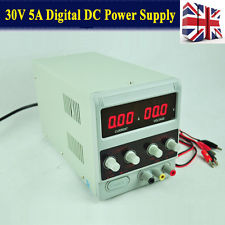Tim-France
Harmless

Posts: 2
Registered: 28-4-2015
Member Is Offline
Mood: No Mood
|
|
Some low tech questions about electro etching
Hi Everyone, I have to let you all know before I start that I am very untechnical but I think this will become obvious.
I've started etching copper jewellery with a 30V 5A DC power supply (bought on Ebay - not sure how good it is) and saturated salt solution (I would
prefer to stick to this if poss). I'm getting mixed results maybe due to my lack of understanding and I hope someone can make it a bit clearer.
I don't understand why the same volts can produce widely different number of amps.
Are the number of amps produced effected by the amount of area being etched - eg could have 2 plates the same size but with different amounts of
copper exposed
Should the negetive plate be the same size as the positive.
The bottom of the tank seems to etch deeper.
I'm using pnp paper as a resist and this is usually very good but I was etching a larger piece recently and a lot of amps were being produced by a
smallish number of volts and the resist failed in a number of places.
Any help or advise would be great.

|
|
|
aga
Forum Drunkard
    
Posts: 7030
Registered: 25-3-2014
Member Is Offline
|
|
The Amps depends on the Volts and the Resistance of your circuit - this is Ohm's Law, namely V=IR where V is Volts (potential), I is Amps (current)
and R is Ohms (resistance).
If you have 30 Volts, and your etching tank circuit measures say 1 Ohm then there will be 30 Amps running through it.
If your etching tank measures 100 Ohms then the current will be 30/100 = 0.3 Amps running through it.
This is why the same voltage gives you a wide variety of Amps.
I would suggest that you use a lower voltage, such as 5 or 6 Volts and a tampon arrangement as the positive electrode.
Forget the Tank.
Attach the negative electrode to the jewellery item, put your etch resist mask over a ball of cotton wool (the tampon) and soak that in your etchant.
Attach the positive electrode to the damp wool and press the whole assembly onto the jewellery item.
Experiment with Time, liquid saturation and Voltage to get the best effects.
|
|
|
macckone
Dispenser of practical lab wisdom
    
Posts: 2168
Registered: 1-3-2013
Location: Over a mile high
Member Is Offline
Mood: Electrical
|
|
For best results, you need a constant current supply. You can then adjust your current for the etch area. The resistance of the tank is altered by
electrode spacing, concentration of electrolyte and etch area. As aga suggested you might get better results at a lower voltage.
|
|
|
aga
Forum Drunkard
    
Posts: 7030
Registered: 25-3-2014
Member Is Offline
|
|
Experts in this field :-
http://www.pryormarking.com/marking-products/electrochemical...
http://www.google.es/patents/US3410782
|
|
|
macckone
Dispenser of practical lab wisdom
    
Posts: 2168
Registered: 1-3-2013
Location: Over a mile high
Member Is Offline
Mood: Electrical
|
|
Cool machine but the cost is probably beyond most of us.
|
|
|
Tim-France
Harmless

Posts: 2
Registered: 28-4-2015
Member Is Offline
Mood: No Mood
|
|
Thanks Aga & Macckone - your information really helps.
|
|
|
DFliyerz
Hazard to Others
  
Posts: 241
Registered: 22-12-2014
Member Is Offline
Mood: No Mood
|
|
I have that exact power supply, and it stopped working correctly after a few months. It can now only go up to about 0.1 amps. Consider buying a
different one!
|
|
|
aga
Forum Drunkard
    
Posts: 7030
Registered: 25-3-2014
Member Is Offline
|
|
Maybe just fix the one you got ?
Man-made artefacts that break can generally be un-broken.
|
|
|